|
Why Linseed Oil Paint?
Long Lasting
Allback Linseed Oil Paints last up
to 3 times longer than modern paints. Not only will the subtle paint
colors decorate your woodwork beautifully, but the linseed oil in
the paint gives protection and nourishment to the wood itself.
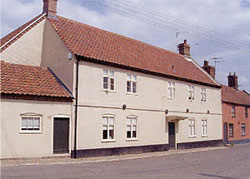
Holkham Estate house, Wighton, North Norfolk renovated in
2002. Windows painted in "Barley White", doors
in "Holkham Green", and render in "Parchment".
(Photo taken 2002) |
Cost Effective
With their dramatically
longer life span, Allback Linseed Oil Paints will yield significant cost
savings over time.
Environmentally Friendly
Allback Linseed Oil Paints are made from natural 100% pure linseed
oil, derived from renewable and sustainable resources.
We use natural paint pigments and no added solvents.
Tested by Several Generations
Linseed oil paint has been used in Scandinavia since the 18th century.
Initially only valuable buildings like churches and mansions were painted
with linseed oil paint. In addition to exteriors, linseed oil
paint has been used both in interiors and furniture, internal doors,
windows and even floor boards.
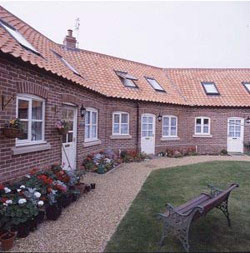
The Millennium Almshouses, Burnham Market, built in 2000/01
to house retired Holkham Estate employees. These were
painted with solvent free Barley White Linseed Oil Paint in
August 2001. |
Best Alternative Even Today
In addition to renovation projects, the natural appearance is also suitable
for new buildings. When selecting a paint one should also consider
durability, coverage and the probability of when repainting might occur.
A cheap paint may prove to be more costly after a few years if it has
to be removed before repainting or if the wooden parts are rotted and
damaged by the use of impermeable paint and need to be repaired.
When a painter / decorator quotes
to repaint the exterior joinery of a house, the cost of the paint is
typically between 8% and 15% of the total cost. The rest is labor.
It therefore pays to choose the right sort of paint so that you are
not having the painters back again for costly repainting four or five
years later.
Best Raw Materials
Genuine Linseed Oil Paint is made in the traditional way from cold pressed
and boiled linseed oil and color pigments. People often think that
"oil" paints smell strongly of and contain solvents.
A genuine linseed oil paint, however, contains no solvents but smells
of delicious linseed oil. You can almost smell the goodness in
linseed oil paint. A traditional linseed oil paint contains no
plastic or alkyd binding medium.
Linseed Oil Paint Works Naturally With Wood
A surface painted with Linseed Oil Paint breathes; therefore the wood
does not decay or rot under the paint. Repainting is easy as Linseed
Oil Paint can always be applied on top of previous coats of linseed
oil paint without difficult and expensive paint removal.
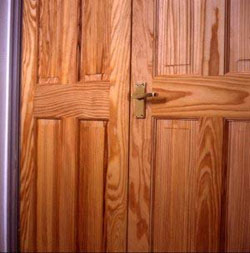
Modern pine door dipped in warm Raw Linseed Oil bringing
out richness of color in the wood, then sealed with casein. |
Linseed usage has declined considerably during the last decades
as the petrochemical and paint industry giants have combined to
drive prices down and spend millions on marketing their modern paint.
Modern polyacrylate dispersion paints have replaced them to a large
extent. Their sole advantage is a rapid application rate and
short drying time hence why they are favored by painters and decorators
who can often apply two or three coats in one day and get into the
next job. But for outdoor use polyacrylates have turned out
less favorably due to their diffusion resistance to water vapor
and poor adherence to the surface to which it is applied, particularly
to wood.
In the outdoor paint market an increasing volume of well-formulated
linseed oil paint is expected. The main drawback of such paints
is that a good result requires the application of three thin layers
with intermediate drying and ideally a prior application of our
purified raw linseed oil. In modern times with cheap materials and
expensive labor costs, linseed oil paints are not the first selection
of the cost orientated builder. However, we try to encourage decision
makers to use Life Cost Analysis as selection criteria when making
their choice of paint as we have here on the Holkham Estate in North
Norfolk.
Why the Holkam Estate has Switched to Linseed Oil Paints
|
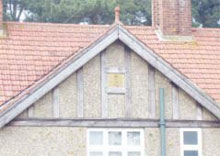
Adjacent cottages with oak bargeboards
before and after "feeding" with warm raw linseed
oil. NB the cast iron pipe painted in "Holkham Green"
Linseed Oil Paint, and the windows restored in 2002.
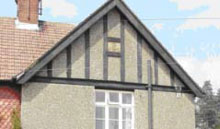
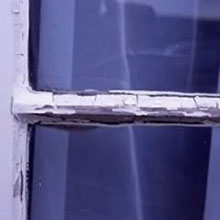
Typical problems associated
with modern alkyd paints: cracking, flaking and allowing
water ingress. Last painted in 1996.
Restored with Allback Linseed
oil, putty and Barley White paint.
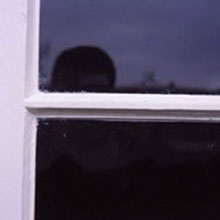 |
The Estate owns roughly 300 properties, all of
which are painted on a six-year cycle. This equates to roughly
50 houses a year, which becomes a pretty expensive exercise. In
addition the modern paints we have been using over the last forty
or so years tend to crack and flake after three to five years
allowing water ingress so that when we come to repaint in year
six there are often expensive joinery repairs to be undertaken
as the wood has rotted under the paint or the putty has no longer
been protected by the paint, has hardened, cracked and fallen
away from the glass.
Our aim, using linseed oil and Allback Linseed Oil Paints, is to move
to a 14-year painting cycle that includes a single coat of Raw
Linseed Oil or our Maintenance Oil at year 7. We have calculated
that despite spending more than double what we normally would
have spent on repairs and repainting (because we are completely
overhauling all windows that need it and painting inside too)
that we will start saving money on each property after 10 to 12
years and that as time goes on those savings will be increasingly
significant because each time subsequent re-paintings will only
require one coat of linseed oil or paint.
Linseed oil paints have higher initial costs, but good length of
life and very low renewal costs. Over a ten-year period linseed
oil paints are more competitive.
Our recommended time scale for treating exterior joinery that
has been painted with Allback Linseed Oil Paints is as follows.
Year 1 Year 1 First coat of the
Organic Purified Organic Boiled Linseed Oil followed by three thin coats
of Allback Linseed Oil Paint (no need to purchase primers, undercoat
and top coat). You can warm the linseed oil by leaving it in the
sun for a while. Use a short stiff natural paint brush.
Every 5 to 10 Years
Give the window / wood a very gentle brush down and then apply
one coat of warm organic Purified Organic Boiled Linseed Oil. This rejuvenates
the pigment in the paint which may have started to fade and brings
back the luster of the color. It also nourishes the wood.
Note 1 : Linseed oil paint is a live material and will age over
time with various outcome. Dry wood will naturally absorb the
organic linseed oil into the wood requiring an application of
the linseed oil more frequently.
Note 2: Organic linseed oil paint will dry with ample access
to oxygen and at a temperature above 50-60 degrees farenheit.
Usually you can apply a new coat after 24 hours. Allow a few days
for the linseed oil to completely dry.
Note 3: Linseed oil paint will dry to a somewhat rubbery surface.
It will always stay flexible and move with the surface changes
during seasonal changes, this is way organic linseed oil paint
will last for such a long time.
Disclaimer: Obviously there
are a number of factors that affect the longevity of the paint
ranging from quality of preparation, workmanship, climatic conditions
and the aspect. Allback Linseed Oil Paints cannot be held responsible
for paint failing as a result of defective workmanship.
|



